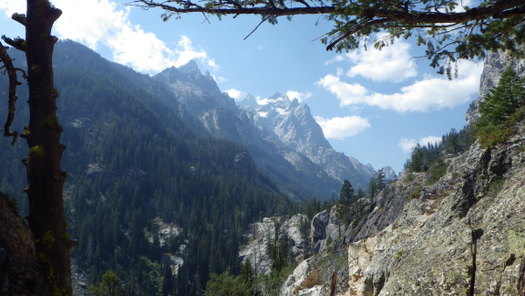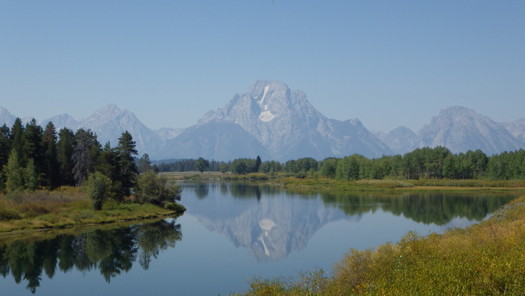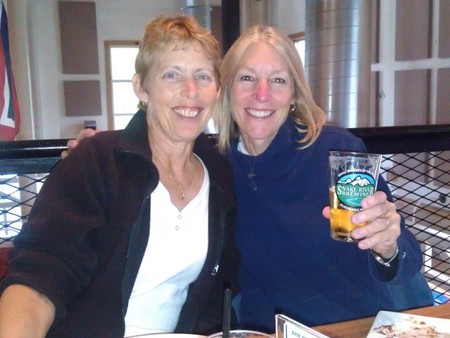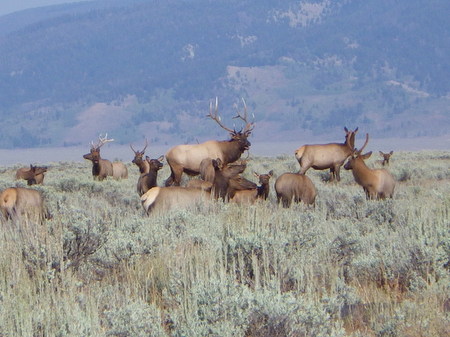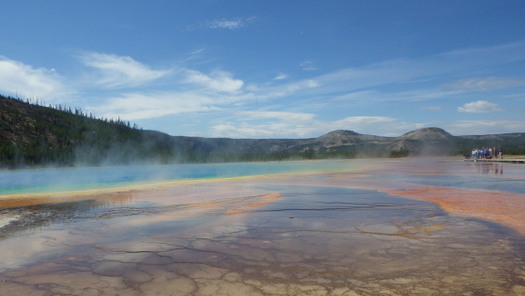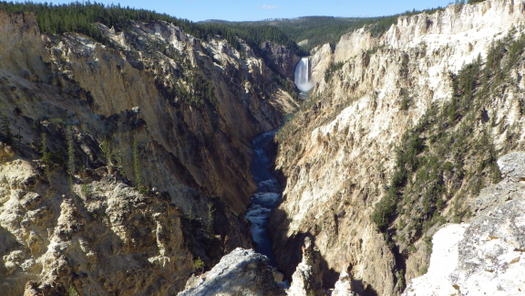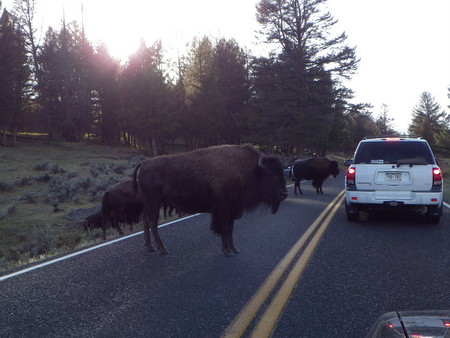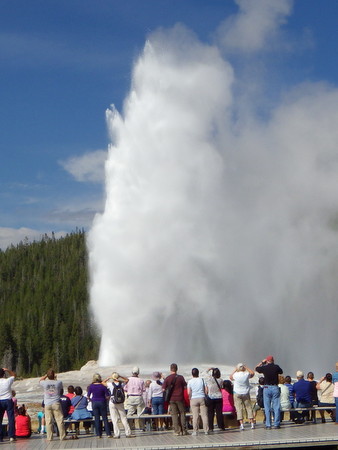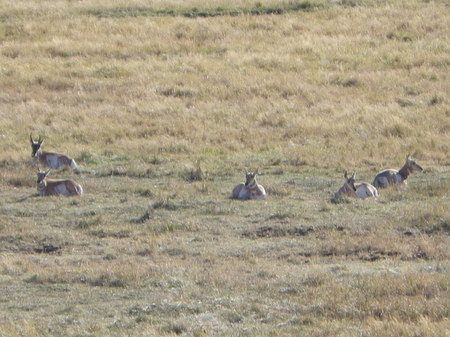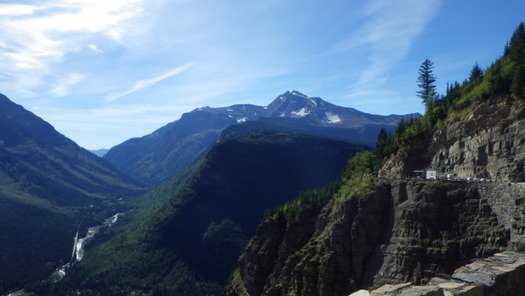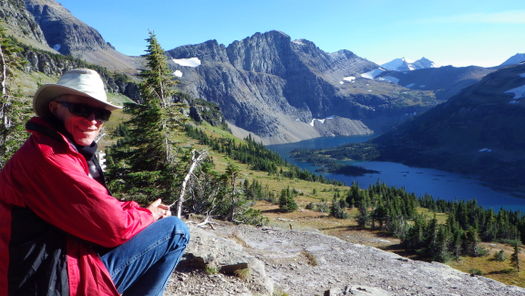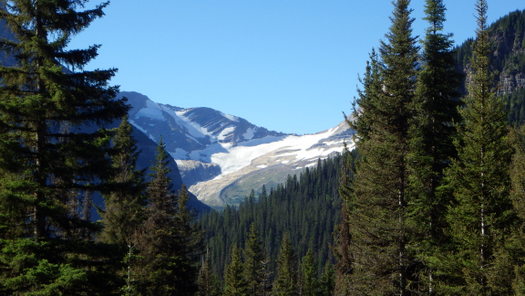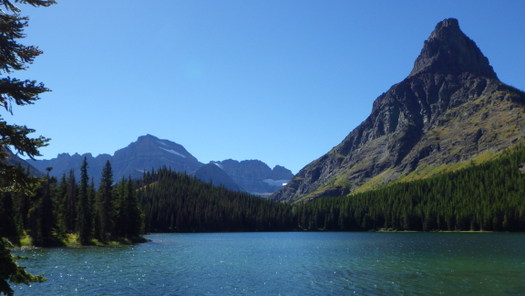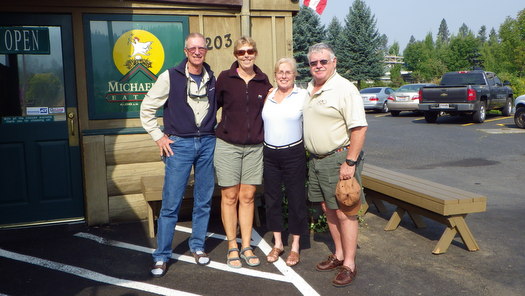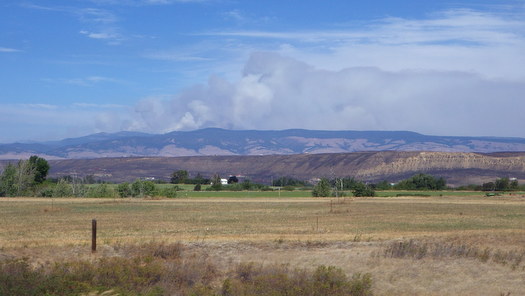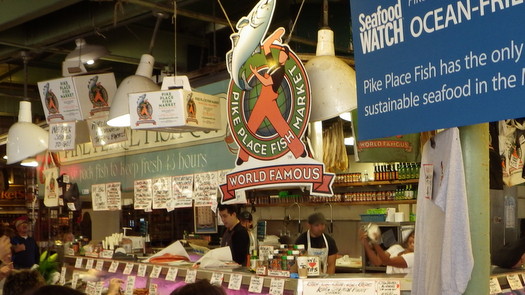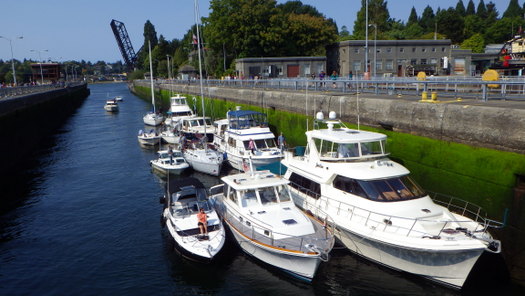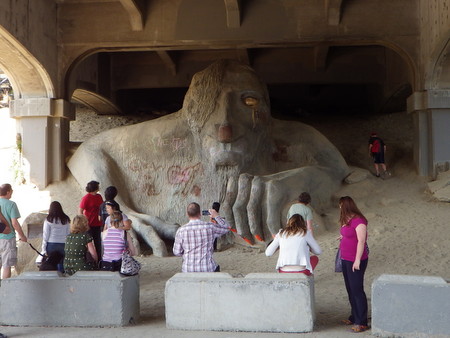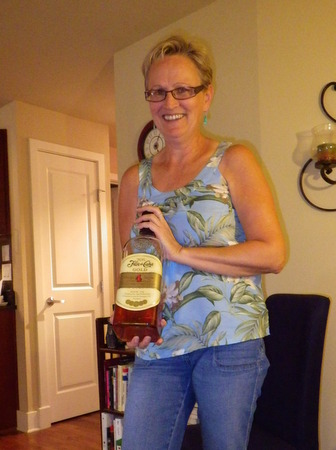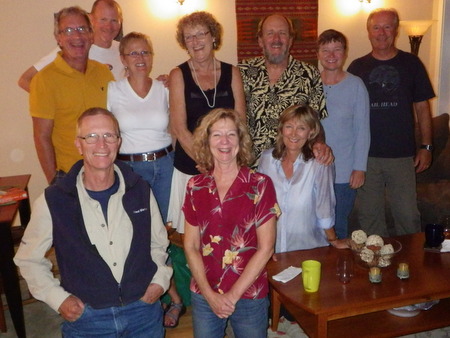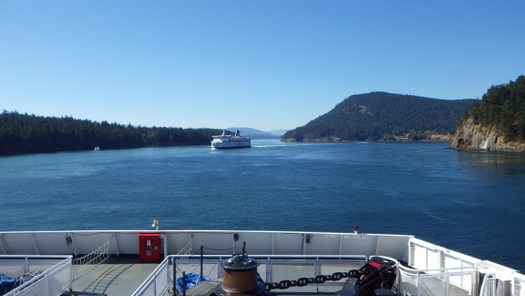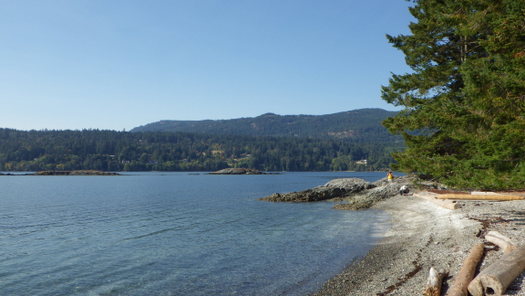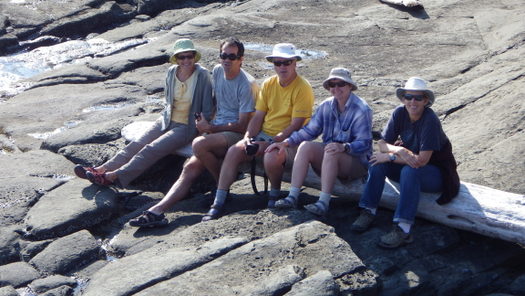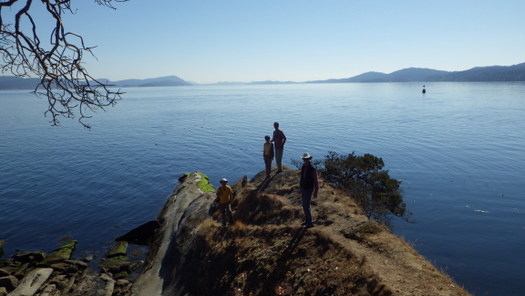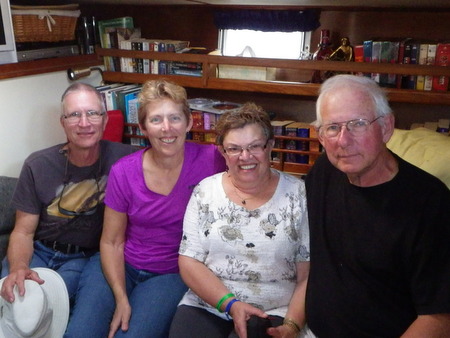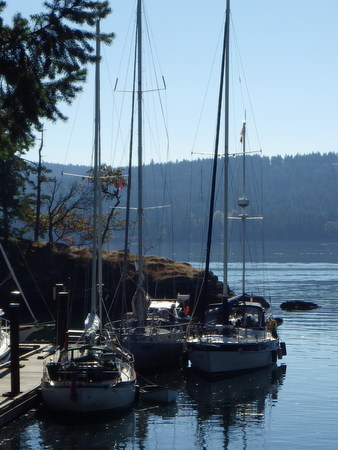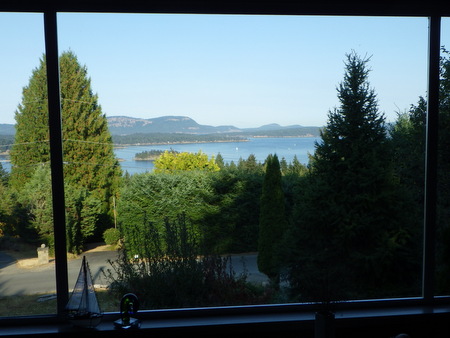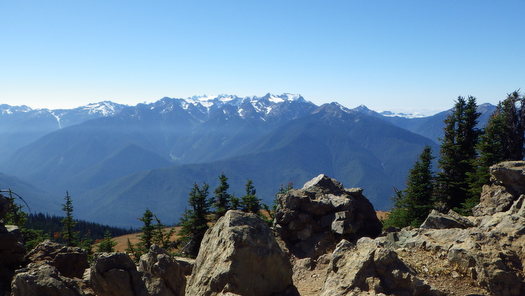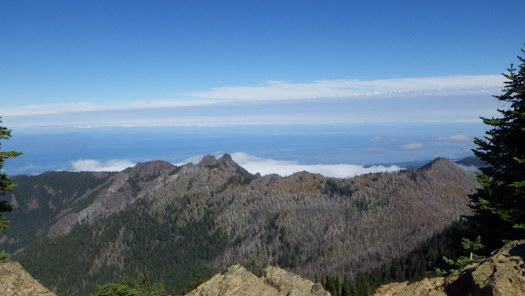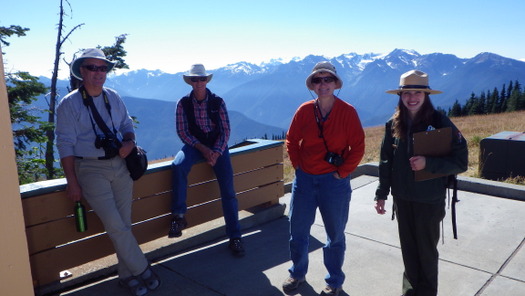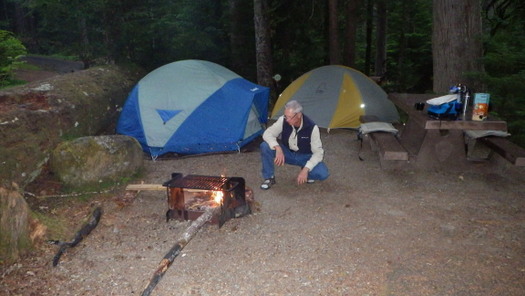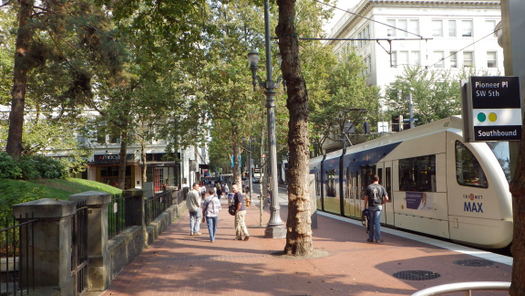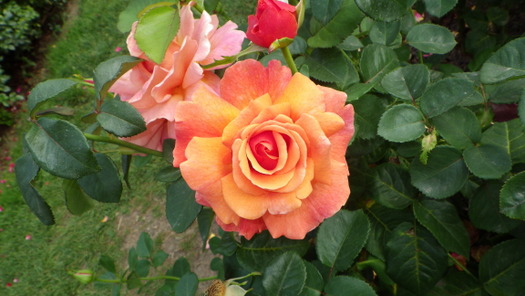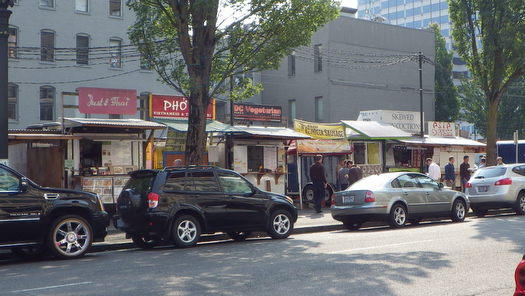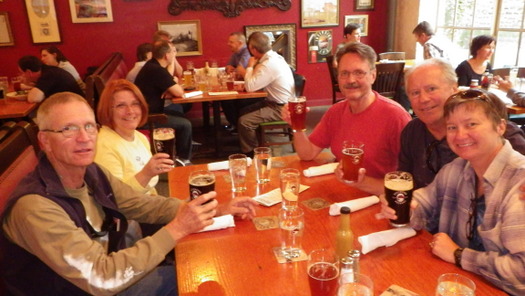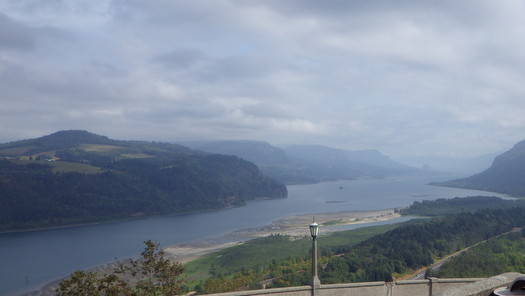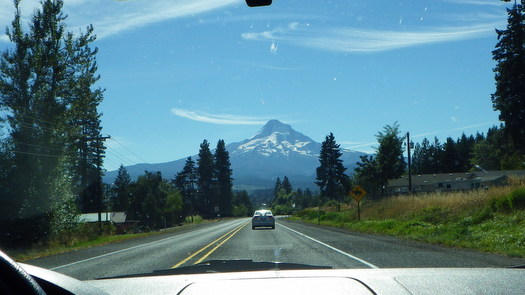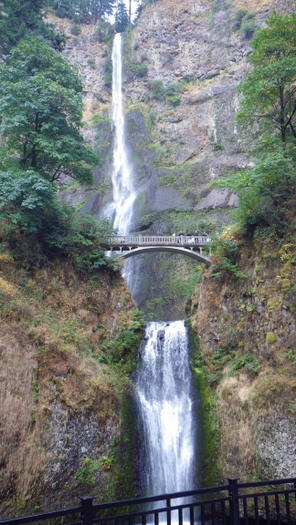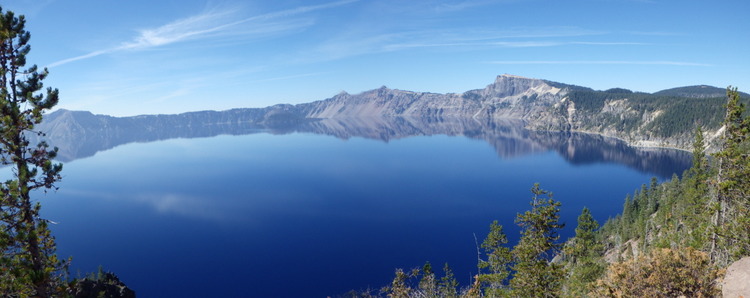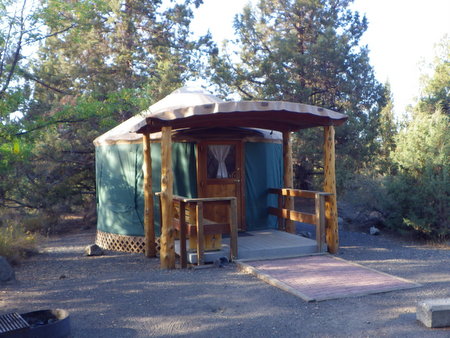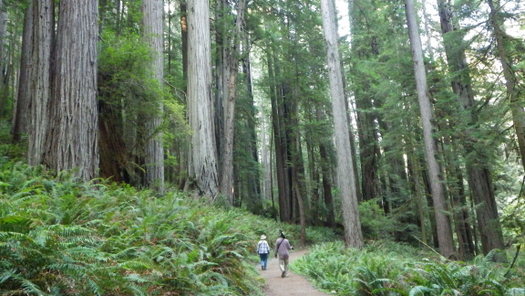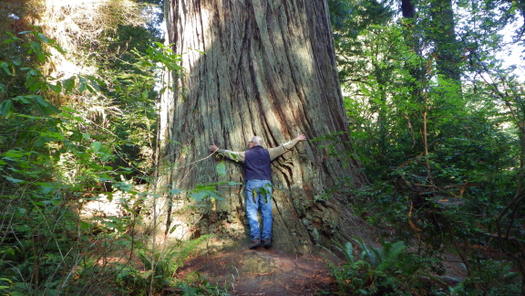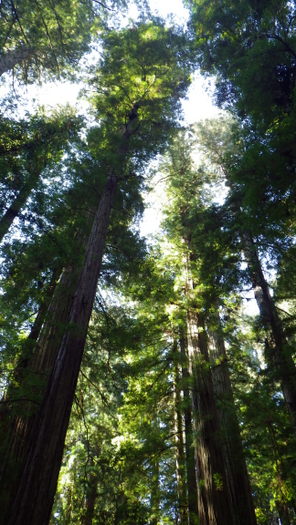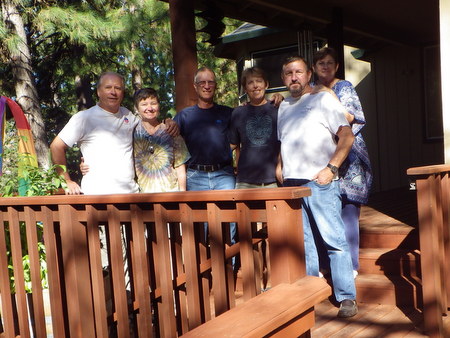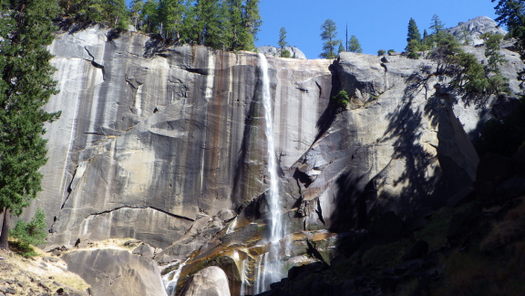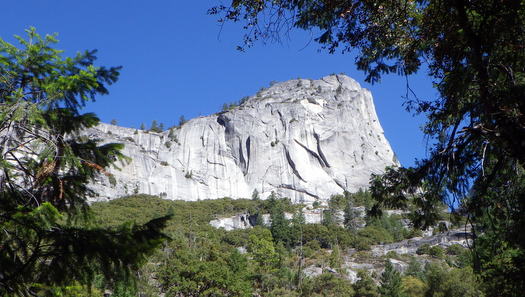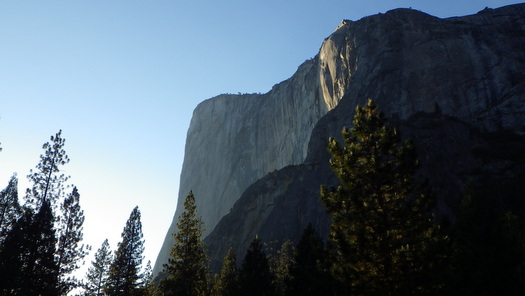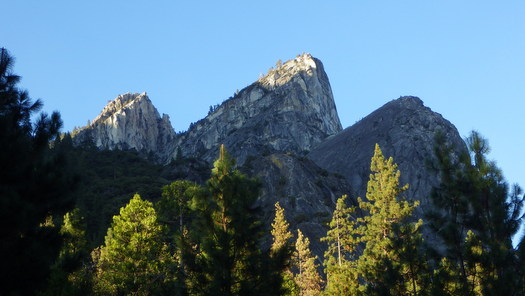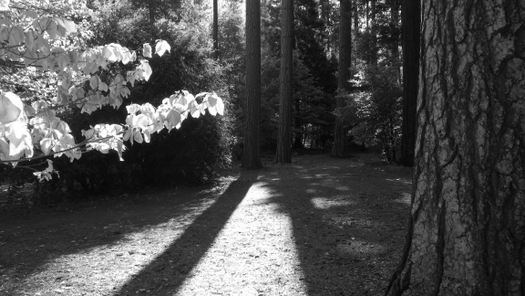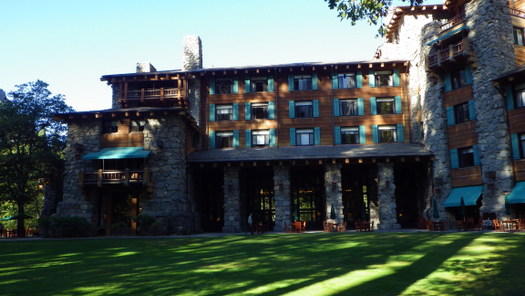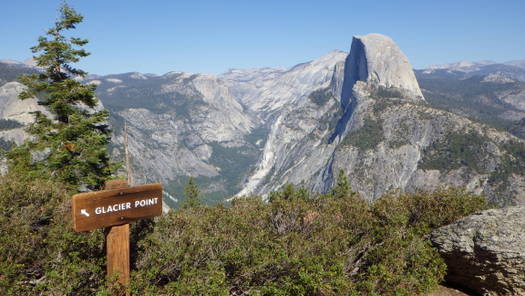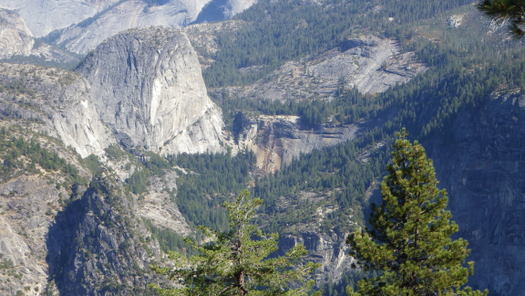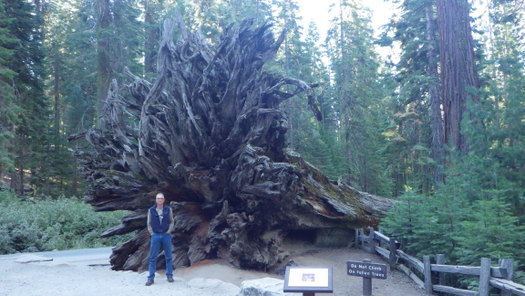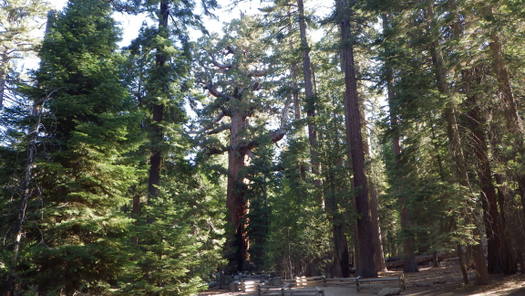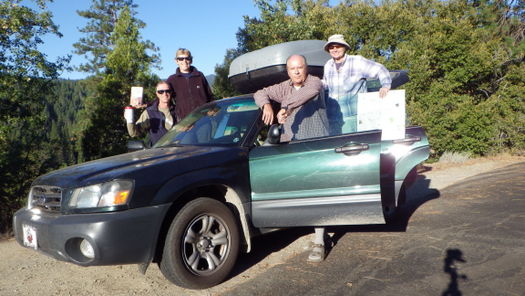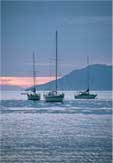
Logbook: USA (Part 2) - September & October 2012
Western U.S. National Parks Tour & Hermosa Beach, CA
When we were still in New Zealand and making plans to visit the U.S. for the summer, we were in touch with our friends Tammy and Susan who live in the Seattle area. We met and became good friends with these two ladies while we were cruising in Mexico and Central America. (Tammy was on s.v. Secret O'Life and Susan on s.v. Last Resort.) They are both living ashore now, and they encouraged us to come visit them while we were back in the States. We loved the idea of seeing them, and neither of us had ever been to Seattle, so we liked this idea. We have a few other friends living in the Vancouver area, and we thought it might be an opportunity to see them too. But then, we were also hoping to visit our friends Pat & Carrie (s.v. Terra Firma) who live near Sedona, Arizona,, and we were trying to figure out how we could fit it all in. So, we called Pat & Carrie to ask if they wanted to make a trip up to the Seattle/Vancouver area with us, since they know all the folks we know in that area. But they came up with an even better idea, and suggested we not only go see our friends, but also do a camping trip to several of the National Parks in the Western U.S. The month of September was perfect timing for all of us. Plans were underway.
The two of us aren't super enthusiastic tent campers, but we find it an OK way to travel, especially since it's a good way to do it economically. We did some weekend camping in a couple of parks when we lived in California, so we knew facilities were usually pretty good. Although our present supply of camping gear was limited to an inflatable mattress, Pat & Carrie had two tents and some cooking gear and could borrow a couple of sleeping bags for us from a friend. We also didn't have much in the way of clothing for cold weather, which we would need since we'd be traveling in higher altitudes and latitudes, but Jan found a couple pairs of long underwear, gloves and caps in her box of ski gear in Mom's basement, and after a quick shopping excursion to a local Goodwill Store, we also had some new (to us) fleece and sweatpants. Pat & Carrie have a Subaru station wagon, so we could all ride pretty comfortably in that, but they thought we might need a bit of extra storage space and found a roof-top "pod" on Craig's List. We were good to go! Carrie proposed a route visiting eight National Parks in six states - Zion (Utah), Grand Tetons and Yellowstone (both in Wyoming), Glacier (Montana), Olympic (Washington), Crater Lake (Oregon), Redwoods and Yosemite (both in California), along with a stop in the Seattle/Vancouver area to visit our sailing friends. After Yosemite, they wanted to head down to San Diego and would drop us off in Los Angeles (Hermosa Beach). Perfect! For a variety of reasons, it worked out best for us to skip Zion and have them pick us up in Salt Lake City on the way to the Grand Tetons. We had visited Zion several years ago, so although we would have enjoyed going there again, at least we weren't missing out on a park we had never seen.
We were calling this a camping trip, but we wouldn't really be camping for the whole month. Pat & Carrie are both electrical engineers, and a few years ago they worked on a job which required them to live in hotels for an extended period, so they accumulated a significant amount of Marriott points. Carrie had picked out a few locations along our route where she thought we might need a break from the camping and used their points to reserve a suite for us at a Residence Inn. Nice! Also, our friends in the Seattle/Vancouver area were willing to put us up during our visit, and we had a few other friends along our route. (Once again, one should never forget that if you ever tell us to stop in and stay with you, we might just show up on your doorstep!)
The proposed road trip route. Pat & Carrie picked us up in
Salt Lake City (letter "C" on the above map).Rich scored big time when he qualified for the National Parks Senior Pass. For $10, he purchased a lifetime senior pass, which got all four of us into all of the National Parks for free, and campgrounds in the parks were half price. While still in Cincinnati, we stopped in at the William Howard Taft National Historic Site, where he bought the pass, and we toured the home of this past president.
September 5 - Cincinnati to Salt Lake City (CVG to SLC). On Wednesday morning after the Labor Day Weekend, Jan's sister Judy dropped us off at the Cincinnati airport on her way to work. We boarded our American Airlines flight to Dallas, and the flight from Cincinnati to Dallas went off without a hitch. It went downhill from there. Our flight from Dallas to Salt Lake City was first delayed about 30 minutes because the crew was coming in on another flight, and that flight was delayed. That wasn't so bad, but after boarding all the passengers, we sat there for quite a long time before the captain announced there was a problem with the plane, and we would have to deplane, and they would find us a new aircraft. Bummer! So, we got off this plane and were directed to a new gate not too far away. The new plane was already there, and about 30 minutes later, they boarded us. Then we sat there and waited some more, and finally the captain came on and said they needed to fuel the plane before we could leave - good idea! Then there was a mix up with the fueling paperwork, and we waited some more. Needless to say, the passengers were getting very restless! We finally departed Dallas and arrived in Salt Lake City three hours late. We were supposed to arrive at 6 p.m. and were looking forward to dinner and a nice evening with our friends at a Residence Inn. Instead, we arrived at 9 p.m. Rats! But, we got to spend the first night of our trip in a Residence Inn. Nice!
Jackson, Wyoming, and the Grand Tetons National Park (September 6 to 8). We got a semi-early start the next morning for the five-hour drive to Jackson at the entrance to the Grand Tetons National Park. Jan's good friend Jayne Bystrom recently moved to Jackson from Miami, Florida, so we were excited to see her. She invited us to stay with her, and we took her up on her offer for a couple of nights. It was a busy time for her at work, so she wasn't able to join us for any sightseeing in the park, but we did have a couple of evenings with her, including one when she showed us around Jackson Hole and took us out to dinner at the local brewery.
The Grand Tetons National Park was established in 1929 and covers 310,000 acres of land, including the jagged peaks and glacier-carved canyons of the Teton range, which are some of the youngest mountains in the world. There are several glacial lakes in the park, the largest of which is Jackson Lake. The Snake River runs through the park, entering Jackson Lake at it's northern end and emerging from the Jackson Lake Dam near the southeastern end of the lake. Just north of the Grand Tetons National Park lie 24,000 acres designated as the John D. Rockefeller, Jr. Memorial Parkway, which connects the Grand Tetons with Yellowstone National Park.
On our first day in Grand Tetons, we did a hike to Jenny Lake, Inspiration Point and portion of the Cascade Canyon. The views of the mountains were gorgeous, although they were somewhat obscured by smoke from nearby forest fires. As we headed back to Jayne's in the late afternoon, we came across a large herd of elk and a small group of moose, including a close (but not too close) encounter with a large bull moose. The next day, we drove north through the Grand Tetons on our way to Yellowstone, and stopped to enjoy the views at several spots in the park, including the Oxbow Bend Turnout, a pretty spot along the Snake River.
Beautiful scenery of the Grand Tetons
Mt. Moran and its reflection in Jackson Lake
Good friends Jan & Jayne at the Snake River Brewing Company
Mr. Moose - maybe a little too close for comfort
Herd of ElkWe were hoping that by traveling in September, the crowds would have cleared out of the National Parks, but there were still a fair amount of tourists. So when we stopped in a park office in the Grand Tetons to buy some bear spray (which we thankfully never needed), we also booked a campsite in Yellowstone for three nights.
Yellowstone National Park (September 8 to 11). We arrived in Yellowstone mid-afternoon and headed to the Madison Campground. We were glad we had booked ahead because the sign at the entrance said it was full. Rich's senior pass got us a campsite big enough for both our tents for $10/night - can't beat that price! We set up our tents and cooked dinner - chicken chili, which became one of our regular camping meals - a can of chicken, a can of corn, a can of black beans and a can of chili-flavored tomatoes, and any leftover salsa from happy hour went in the pot too. Pretty darn easy!
Our first night of camping went pretty well, except that it was cold. When we woke up the next morning, there was frost on the ground and the windshield of the car. Brrr!! We were warm and snug in our down sleeping bags, but it was hard to crawl out of them in the morning. We waited until Carrie had the coffee brewing on the camp stove.
Yellowstone is the oldest U.S. National Park, established is 1872. It covers over 2 million acres (this park is huge!) and is best known for its spectacular geysers, hot springs, waterfalls and canyons. New Zealand is also well known for it's thermal areas, and we had visited some during our travels there earlier this year, but Yellowstone has many more covering a much greater area. Yellowstone has the largest concentration of geysers in the world.
We spent our entire first day in this park looking at geysers, hotsprings, fumaroles, and mudpots. There is an unbelievable number of them to see in this park, and we spent hours walking along boardwalks, exploring the thermal areas and taking tons of photos. The park service gave us a schedule of estimated times for several of the larger geyser eruptions, and toward the end of our day, we made our way to Old Faithful in time to see it blow. The following day, we visited and did some short hiking in the spectacular Grand Canyon of the Yellowstone River area, and in the late afternoon, we drove through the Lamar Valley, where we saw herds of buffalo, as well as other wildlife including pronghorns and coyotes (but no bears).
Grand Prismatic Spring
Lower Falls at the Grand Canyon of the Yellowstone River
Sharing the Road with Buffalo
Old Faithful erupts right on schedule
Family of PronghornsFrom Yellowstone, we drove to Missoula, Montana, where Carrie had booked us a night at a Residence Inn. The warm, comfy bed and hot showers were very nice!! From Missoula, we were headed to Glacier National Park, and the weather forecast was calling for temps to dip into the teens. Yikes! That was significantly colder than Yellowstone, and none of us were really up for camping in that. We found a hotel just outside the western boundary of the park and booked a room for a couple of nights.
Glacier National Park (September 12 & 13). Glacier National Park was founded in 1910 and covers just over a million acres, with glaciers and lakes and beautiful mountain peaks. The park extends north to Canada, where it shares the border with Waterton Lakes National Park in Alberta and forms the Waterton-Glacier International Peace Park. A main attraction of Glacier National Park is the "Going-to-the-Sun" Road, which traverses across the park from its east to west borders - the scenery is spectacular along the way.
It was only a couple hours drive to Glacier from Missoula, so we got there in time to drive part of the Going-to-the-Sun Road on our first day. We first drove up to the Avalanche Creek area and did a short walk along the Trail of the Cedars. We then continued up to Logan Pass and hiked out to Hidden Lake - gorgeous! The next day, we drove Going-to-the-Sun Road all the way across the park and headed up to Many Glacier where we walked the Swiftcurrent Lake Loop Trail. On our way back to West Glacier, we got caught in a traffic jam on the Going-to-the-Sun Road - traffic was stopped for road repairs. Although this is the major "thoroughfare" which cuts across the park, it is a narrow and windy mountain road. We were happy to be driving in a small Subaru and not a big RV. Our only unusual wildlife sighting in Glacier was a mountain goat - still no bears.
Beautiful scenery along Going-to-the-Sun Road
Rich enjoying the view at Hidden Lake
Jackson and Blackfoot Glaciers are still here but much smaller than they once were.
It is estimated that all of the park's glaciers may be gone by 2030.
Views from the Swiftcurrent Lake Loop Trail in Many Glacier
Coeur d'Alene, Idaho (September 14). From Glacier, we headed to Coeur d'Alene, which was about six hours away and half-way to Seattle. We have friends in Coeur d'Alene - Hank & Betsy (s.v. Equinox), whom we met while cruising in the San Blas Islands of Panama. Hank & Betsy have now sold Equinox and bought a beautiful home in Coeur d'Alene. When they heard we were back in the States, they invited us to stop by and stay with them - and we did.
We arrived at Hank & Betsy's mid-afternoon, and a little later in the day, we drove into town and they showed us around. There was an art show and wine tasting event going on, so we stopped in several galleries, sipped some wine and perused some artwork. We also stopped in at the Coeur d'Alene Resort Hotel, a big fancy place where the clientele looked like they had just flown in from Beverly Hills - lots of makeup and plastic surgery on display! After our tour of Coeur d'Alene, we headed back to their home, and Hank & Betsy cooked us a fabulous salmon dinner. The next morning, we all went out for breakfast, and afterward we continued on our way to Seattle. Coeur d'Alene is a very pretty area, but unfortunately, there were some fires in the area, and it was smoky during our visit. But it was great to see Hank & Betsy, and although they lived in Northern California prior to cruising, they have settled in quite nicely and appear to feel very much at home in Coeur d'Alene.
The two of us with Hank & Betsy in Coeur d'Alene
A fire just outside of Coeur d'Alene made it smoky during our visitSeattle, Washington (September 15 to 17). It wasn't a bad drive from Coeur d'Alene to Seattle - about 5 hours - although traffic got significantly heavier as we got closer to Seattle. We arrived at our friend Tammy's condo in Bellevue in the late afternoon, and a couple hours later Susan and her husband Mark joined us there. Susan & Mark are newlyweds, and it was our first time to meet Mark - and we all gave Susan our whole-hearted approval. We had a great time catching up with these friends as we baked pizzas and imbibed a few libations. The two of us stayed at Tammy's in Bellevue, and Pat & Carrie stayed with Susan & Mark in Seattle. The next morning, we gathered for breakfast at Susan & Mark's, and then they took us sightseeing in Seattle - Pike Place Market and the Hiram M. Chittenden Locks (aka Ballard Locks). After lunch at the Maritime Pacific Brewing Company, Tammy took us to see the Fremont Troll, and then we headed back to Susan & Mark's place where two other cruising couples - Roger & Karen (s.v. Meridien) and Brian & Marilyn (s.v. Icarian) joined us for a get-together. It was a full and very fun day!
Pike Place Fish Market
Boats passing through the Ballard Locks
The Fremont Troll
Tammy knows we love Flor de Caña rum from Nicaragua
A fun gathering of sailing buddies - crews from Icarian,
Meridien, Secret O'Life, Last Resort, Terra Firma and Slip AwaySalt Spring Island, British Columbia (September 17 to 21). On Monday morning, our friends in Seattle had to go back to work, and we continued on to Salt Spring Island, in British Columbia, Canada. About five hours and two ferry rides later, we pulled into the driveway of Iain & Aly (s.v. Loon III). Iain & Aly and Pat & Carrie line-handled for us on our first transit of the Panama Canal, and this was the first time since then that the six of us were all together again. Over the next few days, we hiked a few trails on Salt Spring and sailed Loon III (actually motored because there was no wind) to Wallace Island where we met up and spent the day with our friends Bob & Kay (s.v. Kay II). We also played a few games of Farkle, ate delicious meals, shared a few glasses of rum, acted silly at times and talked seriously on a number of subjects. The time flew by - it was hard to say good-bye.
Ferries plying the waters of Canada's Gulf Islands
Coastal scenery on Salt Spring Island
Not sure what Rich said to get our attention for this photo,
but the girls are smiling and the boys have funny looks on their faces!
Hiking on Wallace Island
The two of us with Bob & Kay on Kay II
Loon III & Kay II rafted up together at Wallace Island
Beautiful view from Iain & Aly's homeWe left Salt Spring on a Friday morning and took the ferry to Vancouver Island where we then drove from Sidney to Victoria to catch another ferry to Port Angeles, Washington. The ferry to Port Angeles was booked, and we hadn't even thought about making a reservation, so we were put in the stand-by line. We left the car sitting in line, went out for lunch, and shortly after lunch, we had a spot on the ferry. When we arrived in Port Angeles, we headed a few miles up the road to Olympic National Park.
Olympic National Park (September 21 to 23). The weather in Olympic National Park can be quite wet (part of it is rain forest), and it was lightly misting on us when we arrived. Some of us were grousing and moaning about camping in the rain (Rich. . .), but Carrie ignored our grumblings, directed Pat to the Heart O' the Hills campground, and we set up our tents. It was a wet night outside, but we were fine and dry, and we couldn't beat the price - $6 per night with Rich's Senior Pass. We shared the campground that evening with a group of young partiers - something we maybe should have expected since it was a Friday night and Port Angeles was close by. The music playing until 2 a.m. was mildly annoying but the purple puke in one of the sinks of the ladies restroom the next morning was pretty gross.
Olympic National Park is situated on the Olympic Peninsula in western Washington and covers over 920,000 acres, including most of the Olympic Mountains and its highest peak, Mt. Olympus (7,965 feet or 2,428 meters). The Olympics were designated as a National Monument in 1909, and then as Olympic National Park in 1938. It is internationally recognized as a Biosphere Reserve and World Heritage Site. This region enjoys some of the heaviest precipitation of any area in the U.S., and virgin rainforest is found in the park.
Despite the late night, we were up early on Saturday morning. A light mist was still coming down on us, but the weather forecast was calling for sun, and as we drove up to the Hurricane Ridge Visitor Center, we cleared the clouds. We hiked up to Hurricane Hill, and with sunny weather and crystal clear air, the views were stunning. The rangers at the visitor center told us this was the nicest day they'd had in a long time because during the prior weeks the views were obscured by smoke from fires. After our hike to Hurricane Hill, we joined a ranger-led walk, and the young ranger educated us a bit on the local flora and fauna. Our second night at the campground was much better because it had stopped raining, the bathroom was clean and the revelers from the night before had gone home.
View of the Olympic Mountains from Hurricane Hill
View of the Straits of Juan de Fuca and from Hurricane Hill
Chatting with the park ranger
Rich trying to build us a campfire with wet woodPortland, Oregon (September 23 to 25). The next morning, we packed up our camping gear and headed toward Portland, where Carrie had scored a two-bedroom suite at a Residence Inn for a couple of nights. The hotel was out by the airport, but it was right on the TriMet train line, so we could use public transportation to get into the city.
Our friends Sam & Tom moved to Portland from Southern California a couple of years ago, and we were looking forward to seeing them. They sold their house in Laguna Niguel, moved into a small apartment in downtown Portland, and were loving their new location.
Portland is the largest microbrewery market in the U.S., and all of us like beer, so we were looking forward to sampling some of the local brews. Our first evening in town, Sam & Tom met us for dinner at Burnside Brewing Company, which wasn't far from our hotel - good food and good beer. The following day Sam had to work, but Tom gave himself the day off and showed us around the city. Our first stop was the downtown farmers' market, where we perused the stalls of fresh fruits, veggies and other local delicacies. We then walked all over the CBD and picked up some lunch from some of their food trucks, another "attraction" for which Portland has gained some notoriety. After lunch, Tom drove us out to see the McMenamins Kennedy School, an elementary school in Northeast Portland which has been converted to a hotel, with a restaurant, micro-brewery, theater and soaking pool. After that, we took a stroll through the beautiful and extensive rose gardens in Washington Park. By then it was time for dinner, and we met Sam at the Deschutes Brewing Company for a meal and another sampling of fine local beers. After dinner, we bid farewell to Sam & Tom and caught the train back to our hotel.
Walking the city streets of Portland
The rose gardens in Washington Park were in full bloom - beautiful!
Thai, Vietnamese, Vegetarian, Reindeer Sausage -
something for everyone at the Portland food trucks
Excellent beer at the Deschutes Brewing Company
Columbia River Gorge State Park (September 25). From Portland, we were headed to Crater Lake National Park in Southern Oregon, and Sam & Tom recommended that we visit the Columbia River Gorge State Park on our way out of town. It was a bit of a detour from our originally planned route, but well worth it. We drove east along the Columbia River, which serves as the border between Oregon and Washington State. It's a gorgeous drive, and we stopped for a short hike at Multnomah Falls, which is designated a National Scenic Area. We then turned south and drove along Hwy 197, which runs on the eastern side of the Cascade Mountains, and the views of the mountains along this road were fabulous! That night, we semi-camped, staying in a yurt in the Tumalo State Park, not far from Bend. Several of Oregon's State Parks offer yurt accommodations, which cost more than a campsite, but they are still quite reasonably priced ($35-40/night for a basic yurt, which comes with a set of bunkbeds and a futon). We didn't have a reservation, and all the yurts were booked, but there was a no-show, so we got lucky.
View of the Columbia River Gorge from the Vista House
View of the Cascade Mountains as we driving South along Hwy. 197 -
we think this is Mt. Jefferson, the second-highest peak in Oregon
Multnomah Falls,
which is the second-highest year-round
waterfall in the U.S.
Crater Lake National Park (September 26). The next morning, we drove a couple of hours to Crater Lake National Park. Crater Lake was designated as a National Park in 1902, covers 183,000 acres and is home to the deepest lake in the U.S., formed in the crater of Mt. Mazama, a volcano which erupted almost 8,000 years ago. The waters of Crater Lake are incredibly clear and an amazing color of blue. We spent the day driving along the eastern rim of the lake and walking a few short trails. Beautiful scenery! From Crater Lake, we drove to Oregon's Valley of the Rogue State Park and spent another night in a yurt - quite comfortable and easier than setting up and tearing down tents for just one night.
Crater Lake National Park
Yurt accommodations in Oregon State ParksRedwood National & State Parks (September 27 & 28). The next morning, we had a short drive to Redwood National & State Parks, which cover 110,000 acres in northwestern California. The State of California established three Redwood State Parks - Prairie Creek in 1923, Del Norte in 1925 and Jedediah Smith in 1929. The Redwood National Park was established in 1968 and encircled the three state parks to better protect them. The parks have been co-managed by the National Park Service and the California Department of Parks & Recreation since 1994. They are designated as a World Heritage Site and are part of the California Coast Ranges Biosphere Reserve. The parks are home to groves of ancient redwoods and the world's tallest tree.
We spent our first day in Redwood exploring the Jedediah Smith and Del Norte State Parks, walking trails which wound through groves of these magnificent trees. We camped for the night at the Mill Creek campground, and since the campgrounds are considered to be part of the California State Parks, rather than the National Parks, Rich's senior pass gave us no discount. A space for a tent in this park cost us about the same as a yurt in Oregon! The next day, we drove along the Avenue of the Giants in the Humboldt Redwoods State Park on our way to Cobb, California, near Clear Lake.
Pat & Carrie walking among the giant redwood trees
Rich becomes a tree hugger
Redwood tree tops
Cobb, California (September 28). One might wonder why we would stop in Cobb, CA, but it's half-way between Redwoods and Yosemite, and we have friends who live there! Mac & Alan (s.v. Effie) recently moved ashore and bought a house in Cobb in north-central California. Mac & Alan are some of the first cruising friends we made, and we've spent time with them both on the Pacific Coast of Mexico and in the Caribbean (San Blas Islands of Panama). Pat & Carrie had never met Mac & Alan, but they knew so many people in common that they felt like old friends. Mac & Alan welcomed us with open arms and then shared with us the news that Effie had sold just the day before. We were happy for them but also a bit teary-eyed. We'd shared some good times on Effie. Alan & Mac cooked us a fabulous dinner - tri-tip that was to die for - and we had lots to catch up on that evening. The next morning, Alan cooked up Eggs Benedict for breakfast - we wanted to stay longer! But, it was not to be. Mac & Alan had a commitment later that day, and we were on our way to Yosemite, so after breakfast, we hugged these dear friends, and they sent us on our way with a cooler full of leftovers.
Yosemite National Park (September 29 to October 2). Yosemite National Park was founded in 1890 and was designated a World Heritage Site in 1984. It covers 760,000 acres of spectacular scenery, including beautiful waterfalls and sheer granite cliffs in the Yosemite Valley, which were carved by glaciers a million years ago. Even though the two of us have been to Yosemite several times in the past, we never grow tired of visiting this park - with the caveat that we would never visit during the summer because we couldn't deal with the crowds. This park gets over 3.5 million visitors each year.
In Cobb, California, with Mac & Alan (s.v. Effie)This was Pat & Carrie's first visit to Yosemite, and we were happy to show them some of our favorite spots. We arrived in late September, and the huge summer crowds were gone, but the campgrounds were still busy and looking a bit worn from all the traffic over the past few months. They were also extremely dusty due to a lack of rain from not only a dry summer but also a very dry previous winter. We didn't have any reservations but we were hopeful that we'd be able to find a spot to pitch our tents.
Since we were coming from Northern California, we entered Yosemite through the Big Oak Flat park entrance. It was late on a Saturday afternoon, and there was no hope of getting a campsite on the valley floor, but we secured a spot at the Crane Flat Campground. Yosemite gets a lot of weekend traffic from several nearby large metropolitan areas in California, and the campground on Saturday night was party central - lots of activity and partying into the wee hours. (Guess we're getting some payback from when we were younger!)
On Sunday morning, we were up early, packed up our gear and headed down to Yosemite Valley, which is a seven-square-mile area with towering granite formations. Our first order of business was to try and secure a campsite in the valley for the night. We first stopped at Camp 4, which is a first-come-first-served campground, but it had a huge line. One of the rangers suggested we go to the campground reservation office near Curry Village and get on their list for cancellations. We followed their recommendation, put our name on the list, and headed out for a hike. We needed to check back at the office later in the afternoon, but we had a whole day to explore. One of our favorite hikes is the Mist Trail to Vernal Falls, and we caught a bus to the trail head. During the Fall, the Mist Trail has no mist, and the Falls were barely flowing, but it's still a pretty hike, especially since it was a sunny and warm day. It's been quite a few years since we last hiked this trail, and we were surprised at how difficult it was. In the past, we would continue past Vernal Falls up to Nevada Falls, but we didn't have time for that since we had to get back to the campground reservation office (and our legs would never have made it!). After our hike, we headed back to the campground office, scored a campsite in the Lower Pines campground, and went to setup camp. Once the tents were up, we drove over to the El Capitan picnic area to enjoy some happy hour cocktails and watch the evening sun light up El Capitan - beautiful!
Even with little water flowing at Vernal Falls, it's still a beautiful sight
It's hard to imagine the glacial forces that carved these granite cliffs
The evening sun was hard to capture on El Capitan
And, it was just as pretty on the Three BrothersThe next morning, we packed up our tents once more. Although the location of the Lower Pines campground was quite nice, our plans for sightseeing that day would make it more convenient to stay that night at the Wawona Campground near the South Entrance of the park. From the campground, we headed to the Ahwahnee Hotel, where we joined a free Ansel Adams photography tour. On the tour, we learned a bit more about this talented man who lived in Yosemite for a number of years and took incredible black and white photos of the natural beauty of Yosemite and other National Parks. The tour guide took us to a few locations of some of Adams' famous photos, and told us a bit about the techniques he used. After the tour, we drove up to Glacier Point, so that we could enjoy some of the best views of the Yosemite Valley. The road to Glacier Point is closed in the winter and spring due to snow, so we were in the park at the perfect time of year to see this incredible view.
Jan does her best to replicate one of Ansel Adams' photos
The Ahwahnee Hotel built in the 1920's, and now a National Historic Landmark
The incredible view of Half Dome from Glacier Point
Nevada Falls are barely visible in this photo with little water flowing over them, but
Grizzly Peak, Mt. Broderick & Liberty Cap are beautiful sightsAfter spending the afternoon at Glacier Point we headed to the Wawona Campground. Starting that day (October 1), the Wawona Campground was first-come, first-served, so we were hopeful that there would be a space for us. But there was no need to worry - it was late in the season and mid-week, and we had our choice of campsites. It was pretty much us and the dust! In the Yosemite campgrounds, all food needs to be packed in metal bear boxes at night (yet we sleep in nylon tents?!) because bears in Yosemite have been known to break into cars to get at food and even things like sunscreen which apparently have a pleasant smell to them. In the past, when the two of us spent a weekend in Yosemite's tent cabins, we heard bears roaming through the campground at night, but we saw no signs of bears in Yosemite on this visit.
The following morning, we packed up our tents for the last time. On our way out of the park, we stopped at the Mariposa Grove of Giant Sequoias, and walked a trail that took us past some of the largest specimens of these trees in this park. Having now seen both Redwood and Giant Sequoia trees, it was interesting to compare the two. The Redwoods grow taller - to nearly 380 feet vs. the Giant Sequioa's 311 feet. However, the Giant Sequoias grow to a larger diameter (base to a maximum of 40 feet in diameter vs. the Redwood's 22 feet) and the Sequoias also live longer (up to 3,200 years vs. 2,000 years). The Redwoods are found along the Pacific Coasts of Northern California and Southern Oregon, but the Giant Sequoias grow only on the western slopes of the Sierra Nevada. Just some interesting tidbits of information.
Rich standing at the base of a fallen Giant Sequoia
The "Grizzly Giant" in this grove of Sequoias has a base diameter of 28 feet (8.5 meters)
and is estimated to be almost 1800 years old.
Our departure from Yosemite brought our National Parks Tour to a close. The four of us had just spent four weeks traveling 4,000 miles to seven National Parks for two of us (eight for Pat & Carrie). We saw some fabulous places, and it was a great opportunity to visit some good friends along the way. We laughed a lot, and there was never an argument between us, although there was some eye-rolling by the girls in the back seat when the boys in the front seat decided they were singers - yikes! Our only disappointment was that we never saw any bears, but at least we didn't run into any on the trails as we were out hiking. We also felt that we needed more time in each of these parks - there is just so much to see in each one. We have lots of great memories of this trip - lucky us to have such good friends with whom we could share this experience!
The U.S. National Parks are outstanding, and we would highly recommend them to others. A guidebook that we found very helpful for this trip was Fodor's The Complete Guide to the National Parks of the West. We've been fortunate to see a fair amount of this world, yet we still found these U.S. National Parks to be exceptionally beautiful and special places.
From Yosemite, we headed to Los Angeles. Pat & Carrie were dropping us off in Hermosa Beach at the home of our friends Camille & John. Camille & John had another house guest in addition to the two of us - their niece Jenny who was temporarily living with them while attending school in Long Beach - so Pat & Carrie stayed the night at a hotel just around the corner. That evening, we all enjoyed dinner together, and the next morning, we walked down to the hotel to have breakfast with Pat & Carrie and say good-bye before they took off for San Diego.
The four of us with the Subaru and its "pod", our guidebook and a map (although Carrie
usually got us places with her smart phone). Still smiling after a month on the road!Hermosa Beach, California (October 2 to 30). We spent the remainder of October at John & Camille's in Hermosa Beach. It felt good to be in a place that still feels a bit like home to us, and we were especially happy to be staying put for several weeks. We'd spent a good part of this year on road trips, starting with our two-month road trip in New Zealand, continuing with the numerous excursions we made from Cincinnati, and then this last month visiting the National Parks and friends in the Northwest. It was fun, but we were weary. Although we are accustomed to regularly traveling to new places, we're usually doing so on Slip Away, so we're taking our home with us. Our friend Kathy (s.v. Jumbie) described it perfectly - we were like turtles traveling without our shell.
Our first couple of weeks in Hermosa, we felt almost reluctant to leave the house, and when we did, we preferred not to drive anywhere. One of the nice things about Hermosa Beach is that most of what we wanted was within walking distance - the grocery store, the West Marine store, a gym for Rich and a yoga studio where Camille and Jan attended classes frequently. Additionally, we needed to do some shopping, and doing it on the internet was the easiest way to get it done. Slip Away was waiting patiently in the boatyard in New Zealand for us, and we had a number of boat projects we wanted to do when we returned to her. Most everything in New Zealand is more expensive than it is in the U.S., and since Slip Away was temporarily imported into the country, we could bring back boat parts and other items duty-free. Although we would have to pay excess baggage charges on the airline, it was still less expensive, and also less hassle than trying to find and buy the items there.
We had a 2½ page list of items we wanted to buy, so we divided it between the two of us. We took over the dining room as our office, and with Rich on his iPad and Jan on the laptop, we started ordering. Our credit cards were smoking, and we became well acquainted with the UPS, Fedex and Post Office employees, as they brought us packages daily. We own a few large soft suitcases which we brought back to the U.S. with us, but we needed a few more, so we visited the local Goodwill and Salvation Army Stores to buy some (a couple of them really nice bags!). As our boat stuff started arriving, we started packing - everything from plumbing and electrical parts to tools and fasteners to Sunbrella fabric and Coppertone sunscreen. We'd purchased a luggage scale, which was worth its weight in gold - much easier than stepping on and off a bathroom scale while holding a heavy bag, since we were trying to pack the maximum allowable weight in each.
A number of friends visited with us in Hermosa, and we eventually did get out and about to visit a few others. One evening, as we drove up to Brentwood to meet some friends for dinner, the route took us near our old neighborhood in Santa Monica, and we had very pleasant feelings of nostalgia. Although we no longer want to live in such a large city, we enjoyed it when we did. We thought a month in L.A. would give us enough time to see everyone we wanted to see, but the time slipped away and there were a number of people we never even had a chance to call.
As always happens, before we knew it, it was time to go. Our bags were packed - we had eight 50 lb. pieces of checked luggage between us, plus each of us had a carry-on and a backpack. We needed two cars to get us to the airport! Fortunately, Camille & John live only about 6 miles from LAX. They packed us up, hauled us to the airport and then helped us unload. It's always hard to say good-bye to Camille & John, but they are planning to come see us in Fiji, so we're very excited about that!
The airline check-in went smoothly, and the agent checking us in was quite impressed that each of our checked bags weighed between 49.5 and 50 lbs. - not a one was over! We had also read the airline rules about restricted weights for carry-on bags, but fortunately, they didn't weigh those because we cheated a bit on that! Once the bags were checked, we made our way to the gate, and we were ready to go home.

